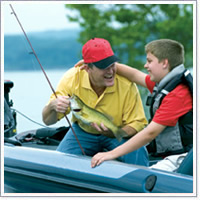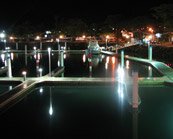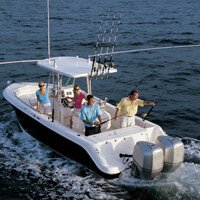Small, easily-misplaced items like hook removers, fishing and/or split-ring pliers, and hook sharpeners can be kept organized and quickly accessed if you stow them on the underside of a hatch. The only problem with this is that if the hatch is fiberglass and the material used to make it isn’t very thick, there might not be enough there to hold screws of reasonable length. And who wants to drill a bunch of holes all the way through a perfectly good hatch?
My answer was to first install a piece of quarter-inch pre-painted plywood on the underside of the hatch using a generous bead of marine adhesive/sealant around the perimeter – just in from the edges. Tape firmly in place and allow at least three days to completely cure before mounting anything on it.
Hook-sharpening files are subject to instant rust, unless you stow them in a protected, lubricating sheath. Attach it to the plywood via two short stainless steel screws.
Fishing pliers, hook removers, etc. can be held firmly in place on the plywood via short pieces of vinyl tubing of the right diameter for a snug fit.
- Drill two holes through one side of the tubing and then use an ice pick on the other side to make starter holes for two flat-head stainless steel screws of the right length.
- If the tubing is not quite as snug as you’d like, use a cable tie to tighten it up just enough near the end where the tool is inserted.
Incidentally, several years ago after having my original pistol-grip hook remover tossed overboard by a rambunctious tarpon with a plug deep in its throat, I added a wrist lanyard made of lightweight bungee to the handle.
Later, I also added a leader stretcher for pre-rigged flies, which I made longer by moving one end off the original 3/4-inch aluminum angle frame. Since then, I’ve realized that only two pieces of angle aluminum are really needed for this: the two on the ends—the side rails are superfluous. Quarter-inch holes are simply drilled in one end to accommodate the thin bungee loops that hold the hooks. I cut slots in the other piece of angle with a hacksaw, then sanded the edges lightly to remove any roughness that might cause damage to the ends of the shock leader where they are inserted just below the knot. A strip of Velcro is used to keep the looped sections of the class tippet from hanging loose and getting tangled.
These pieces can be mounted directly to the underside of the hatch with suitably short stainless steel screws, or via pieces of plywood as I did with the various tools in the photo.
Contributed by Bob Stearns. Content courtesy of Center Console Angler.


